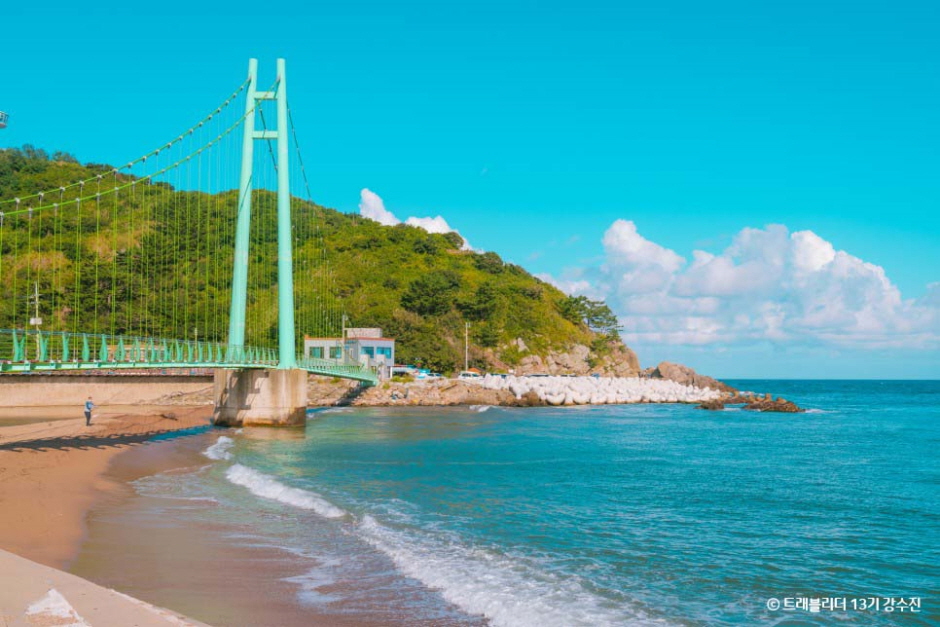Unification Security Park (통일안보공원)
2025-01-13
481 Geumgangsan-ro, Hyeonnae-myeon, Goseong-gun, Gangwon-do
Unification Security Park serves as the entry point to the Unification Observatory. Before entering the observatory, visitors can watch a video at the Education Security Hall, which has a seating capacity of 700 people. In front of the Education Security Hall, stands the Peace Bell, a symbol of hope for peaceful reunification. Additionally there is a monument commemorating the army unit members who sacrificed their lives to stop the invasion of North Korean guerillas just before the Korean War.
◎ Due to its location within the Civilian Control Line area, visitors must complete the required procedures before entering.
Daejinhang Port (대진항)
2025-01-13
Daejinhang-gil, Hyeonnae-myeon, Goseong-gun, Gangwon-do
Daejinhang Port is located at the northernmost tip of the east coast of Korea. Since the opening of North-Eastern Railways in 1935, the port has become a transportation hub, facilitating the transport of seafood and agricultural products to Wonsan.
Jukdosan Observatory (죽도산전망대)
2025-01-10
90 Chuksanhang-gil, Chuksan-myeon, Yeongdeok-gun, Gyeongsangbuk-do
Jukdosan Observatory is located along the Yeongdeok Blue Road Course B. The building consists of seven floors in total with a lighthouse on the 7th floor. The main observatory on the 5th floor provides a stunning 360-degree view of the Chuksanhang Port and Yeongdeok. Visitors can also enjoy coffee and snacks at the outdoor observatory on the 2nd floor.
Gyeongjeong Village (Chayu Fishing Village) (경정마을(차유어촌체험마을))
2025-01-10
Gyeongjeong-ri, Chuksan-myeon, Yeongdeok-gun, Gyeongsangbuk-do
Gyeongjeong Village, also known as Chayu Fishing Village due to its saddle-like shape, is located along the beautiful east coast of Korea. The village is renowned for its snow crabs that were offered to the king since ancient times as well as the snow crab monument. Other specialties of the village include wild seaweed, dried squid, and sea urchin. The village offers experience programs like night crab catching, snow crab catching, lantern experience and other diverse programs that are loved by children. Located at the heart of the picturesque sea trail of Yeongdeok, Blue Road Course B, the village is surrounded by notable tourist attractions including, Gyeongjeong Beach, Gyeongjeonghang Port, and Chuksanhang Port.
BTMedi Inc. (주식회사 비티메디)
2025-10-23
#605, 32-19 Gobong-ro, Ilsandong-gu, Goyang-si, Gyeonggi-do
BTMedi is a representative company specializing in medical tourism in Korea. It offers optimum medical services for international patients by leveraging its multi-year experience and expertise.
The company operates Koreamedis.com, the largest medical tourism platform in Korea. BTMedi's one-stop concierge services, including hospital reservation, medical interpretation, and accommodation & transportation support, guarantee patients a comfortable and safe medical travel experience.
BTMedi puts the highest priority on customers' health and satisfaction and offers customized medical solutions considering each patient's individual needs. Enjoy your medical tour in Korea safely and comfortably with BTMedi, a trusted partner committed to providing the best medical experience.
WOOA Plastic Surgery (우아성형외과의원)
2025-11-26
492 Gangnam-daero, Gangnam-gu, Seoul
WOOA Plastic Surgery was formerly Regen Plastic Surgery and Dermatology in Apgujeong. It is run according to the treatment philosophy of Director Woo-jung Kim, the founder of Regen Plastic Surgery who earned a doctorate in plastic surgery at Seoul National University.
WOOA Plastic Surgery is a global comprehensive beauty brand encompassing plastic surgery, dermatology, and cosmetics, with the vision of providing responsible medical services and realizing elegant beauty for each patient.
The clinic is committed to ceaseless research with the goal of becoming a leading medical institution that produces leaders to drive medical developments in Korea. It aims to become a global comprehensive beauty brand, with employees who all prioritize customers' safety and rapid recovery.
Trinity Women's Clinic (트리니티여성의원)
2025-10-23
3F, 108 Dosan-daero, Gangnam-gu, Seoul
Trinity Women’s Clinic provides the best medical service for women suffering from health issues unique to women, such as vaginitis, fibroids, and menopause.
The clinic aims to enhance patients’ quality of life through accurate and safe treatments. It aspires to become a reliable clinic that treats both women's minds and bodies. The clinic focuses on women's health and uterine treatments. At the same time, it guarantees optimum outcomes realized through its proven facilities, equipment, and safe medical environment.
Through continuous technological development and acquiring new medical knowledge, Trinity Women’s Clinic offers innovative treatments, including HIFU procedures, to improve patient health.
ID Clinic (Sinsa Branch) (아이디의원(신사점))
2025-10-23
6F, 142 Dosan-daero, Gangnam-gu, Seoul
ID Cosmedical Group, consisting of ID Plastic Surgery and ID Dermatology, has launched a beauty clinic brand with a new concept that combines its extensive expertise and experience.
Based on its high-quality medical services, ID Clinic offers personalized beauty solutions with exceptional convenience at reasonable costs.
ID Hospital (아이디병원)
2025-10-23
142 Dosan-daero, Gangnam-gu, Seoul
ID Hospital offers innovative medical services and one-stop solutions, delivering value that is more than just beauty. A plastic surgery clinic comparable to a large hospital, ID Hospital ensures safe, personalized treatments with cutting-edge technology and world-class expertise.
From facial contouring to Mommy Makeover, the clinic creates harmonious transformations that enhance patient's natural beauty and confidence.
Luke Korean Medicine Hospital (누가한방병원)
2025-10-23
218 Andeogwon-ro, Deokjin-gu, Jeonju-si, Jeonbuk-do
Luke Korean Medicine Hospital combines traditional Korean medicine and Western medicine.
It specializes in detoxification, pain management, and rehabilitation, and its director has dedicated himself to practicing traditional Korean medicine following the footsteps of his father, continuing over 50 years of history in total.
The hospital analyzes, improves, and treats the root causes of various diseases caused by modern lifestyle habits and dietary patterns.
The hospital’s vision and aspiration are to help customers lead a healthy and beautiful life.
It developed programs that allow customers to experience both traditional Korean and Western wellness in Jeonbuk-do. The hospital is dedicated to offering this special and valuable wellness experience to more people.


 English
English
 한국어
한국어 日本語
日本語 中文(简体)
中文(简体) Deutsch
Deutsch Français
Français Español
Español Русский
Русский